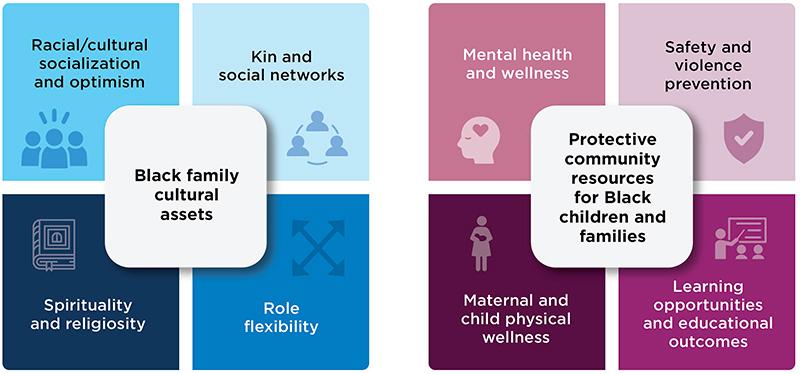Priorities for Child Trends’ Applied Research Agenda on Black Children and Families
Author
Child Trends’ applied research agenda on Black children and families will focus on two priority areas: Black Family Cultural Assets and Protective Community Resources for Black Children and Families. Below, I describe the importance of these priorities for expanding and deepening research that can inform policies and practices to promote the well-being of Black children and families.
Children’s families and communities arguably have the most significant direct effects on their development and well-being across all ages and developmental stages. By definition, successful families and communities engage in socializing practices that help children and youth develop the skills, dispositions, and behaviors they need to thrive in the societies to which they belong. The degree to which families and communities successfully carry out these roles (or fail to do so) largely depends on their economic, structural, and relational characteristics; these, in turn, determine how they navigate the systems (i.e., economic, political, criminal justice) that directly and indirectly affect them.
Structural racism (i.e., racism that is deeply embedded in the laws, policies, and norms of a society) presents unique challenges for the socialization of Black children and youth in the United States, requiring families and communities to prepare their young people for both society as it is (e.g., characterized by racialized discrimination and violence) and for society as it should be (e.g., characterized by equitable opportunities for self-actualization and well-being).
Child Trends’ new multi-year research focus on Black Family Cultural Assets and Protective Community Resources for Black Children and Families will deepen our understanding of how families and communities meet these challenges to help Black children and youth flourish; explore some of the specific challenges that families and communities face and the resources on which they draw to meet these challenges; and offer considerations for how policies and practices can maximize Black children’s and families’ capacity to prosper.
Black Family Cultural Assets
Child Trends’ research on Black Family Cultural Assets will examine the significance of historically documented assets—including optimism, kin and social networks, spirituality and religiosity, and role flexibility—for Black families’ stability and well-being. We’ll also explore factors that affect the saliency of these assets among families that differ in multiple ways, including their composition and levels of education and income. Below are examples of research questions we might investigate under this priority:
- How do cultural assets present in Black families change based on family characteristics, and what are the implications of such changes for programs supporting Black families?
- How do social safety net programs leverage, fail to take advantage of, or undermine Black family cultural assets?
- How do frameworks specifically designed to combat anti-Black racism (e.g., The Protect, Promote, and Preserve (3Ps) Framework) facilitate the examination of policies and programs to identify and address systemic inequities?
Protective Community Resources for Black Children and Families
Child Trends’ research on Protective Community Resources for Black Children and Families will identify community-based factors that promote Black children’s and families’ well-being. We’ll examine how these factors are related to mental health and wellness, community safety and violence prevention, maternal and child health, and learning opportunities and educational outcomes for children across all ages and developmental stages. Below are examples of research questions we might investigate under this priority:
- How do Black children, adolescents, and families describe the availability and quality of protective community resources? What community resources do they identify as most desired, and why?
- To what extent does the availability of protective community resources improve outcomes for Black children, adolescents, and families? How does availability of these resources differ by families’ geographic location or income, age of child, and other factors?
- What cities have been most effective in promoting protective community resources for Black children and families and what have been their approaches?
As we pursue research in these priority areas, we will use a racial equity approach that is asset-based; that centers the voices and experiences of Black children and families; and that explores the ways in which race intersects with other dimensions of identity, including ethnicity, immigration status, socioeconomic status, gender, sexual orientation, and geographic location. Through our efforts, we will develop new knowledge that advances understanding of the diversity, strengths, and needs of Black children and families, as well as the ways in which policies and practices can be mobilized to dismantle racial inequities and build the conditions and contexts that these young people (and all children and youth) need to succeed.
Priorities for Child Trends’ New Applied Research Agenda on Black Children and Families
Related Research
- An Applied Research Agenda on Black Children and Families to Advance Practices and Policies That Promote Their Well-being
- Reimagining Black Families’ Cultural Assets Can Inform Policies and Practices That Enhance Their Well-being
- Racism and Discrimination Contribute to Housing Instability for Black Families During the Pandemic
- Service and Advocacy Organization Leaders Share Insights for an Applied Research Agenda on Black Children and Families
- Black Children and Adolescents Can Achieve Greater Heights With Research-informed Policies and Practices

Suggested Citation
Sanders, M. (2023). Priorities for Child Trends’ applied research agenda on Black children and families. Child Trends. https://doi.org/10.56417/3776m5287m
© Copyright 2024 ChildTrendsPrivacy Statement
Newsletter SignupLinkedInThreadsYouTube